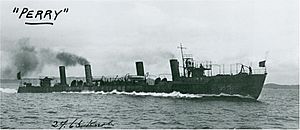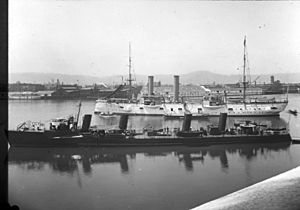USS Perry (DD-11) facts for kids

USS Perry, 27.65 knots on speed trials in San Francisco Bay April 30, 1902.
|
|
Quick facts for kids History |
|
|---|---|
| Name | Perry |
| Namesake | Commodore Oliver Hazard Perry awarded Congressional Gold Medal |
| Builder | Union Iron Works, San Francisco |
| Laid down | 19 April 1899 |
| Launched | 27 October 1900 |
| Commissioned | 4 September 1902 |
| Decommissioned | 2 July 1919 |
| Stricken | 15 September 1919 |
| Fate | Sold, 3 January 1920 and broken up for scrap |
| General characteristics | |
| Class and type | Bainbridge-class destroyer |
| Displacement |
|
| Length |
|
| Beam | 23 ft 7 in (7.2 m) |
| Draft | 6 ft 6 in (2.0 m) (mean) |
| Installed power | |
| Propulsion |
|
| Speed | 29 kn (54 km/h; 33 mph) (designed speed) |
| Complement |
|
| Armament |
|
The USS Perry was a special type of ship called a destroyer in the United States Navy. She was the second ship to be named Perry. This ship was named after Oliver Hazard Perry, a famous naval hero. The Perry was part of the Bainbridge class of destroyers.
Contents
Building the USS Perry
The Perry started being built on April 19, 1899. She was constructed by Union Iron Works in San Francisco, California. The ship was officially launched on October 27, 1900. A young woman named Miss Maude O'Connor helped launch the ship. The Perry was ready for service and joined the Navy on September 4, 1902.
Before World War I

The Perry was part of the Pacific Torpedo Flotilla. This group of ships was based at Mare Island in California. Her missions took her to many places. She sailed north to Alaska and south along the coast of Mexico. In the fall of 1908, the Perry took part in large fleet exercises near Hawaii.
Helping San Francisco in 1906
One of the most important moments for the Perry happened on April 18, 1906. A huge earthquake hit San Francisco. A terrible fire followed, destroying much of the city. For four days, the crew of the Perry worked hard to help. They fought fires and patrolled areas to stop looting. They also gave medical help to many injured people.
Watching the Mexican Revolution
In 1914, the Perry was sent to watch the naval battles in the Gulf of California. This was during the Mexican Revolution. She was present at the Fourth Battle of Topolobampo. This was the last naval fight of that campaign.
During World War I
When the United States joined World War I, the Perry first patrolled off the California coast. Then, on July 28, 1917, she sailed to Panama. Her job there was to guard the entrance to the very important Panama Canal.
On May 30, 1918, the Perry moved to Key West, Florida. She helped patrol the Florida Keys. After the war ended, she sailed to the Delaware Bay on January 29, 1919. The Perry stayed at the Philadelphia Naval Shipyard until she was taken out of service on July 2, 1919. Her name was removed from the Navy's list of ships on September 15, 1919. Finally, on January 5, 1920, she was sold to a company to be taken apart for scrap metal.
Commanding Officers
Some notable officers commanded the USS Perry:
- Frank Herman Schofield: He was a Lieutenant Commander from 1904 to 1905. He later became a Rear Admiral.
- Edgar Brown Larimer: He was a Lieutenant from 1907 to 1909. He also became a Rear Admiral and led the Bureau of Ordnance.
- Harry Adrian McClure: He was a Lieutenant Junior Grade from 1915 to 1916. He later became a Commodore.

